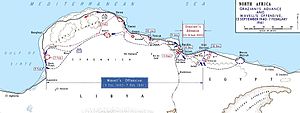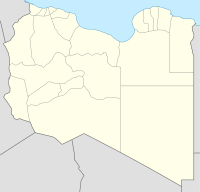Battle of Beda Fomm
| Battle of Beda Fomm | |||||||
|---|---|---|---|---|---|---|---|
| Part of Operation Compass, during the Second World War | |||||||
 British pursuit 9 December 1940 – 7 February 1941 |
|||||||
|
|||||||
| Belligerents | |||||||
|
|
|
||||||
| Commanders and leaders | |||||||
|
Archibald Wavell Richard O'Connor Michael O'Moore Creagh |
Rodolfo Graziani Giuseppe Tellera † Annibale Bergonzoli (POW) |
||||||
| Strength | |||||||
| Western Desert Force (XIII Corps from January 1941) | 10th Army | ||||||
| Casualties and losses | |||||||
| part of 1,928 9 December 1940 – 9 February 1941 |
25,000 | ||||||
|
|
|||||||
The rapid British advance during Operation Compass (9 December 1940 – 9 February 1941) forced the Italian 10th Army to evacuate Cyrenaica, the eastern province of Libya. In late January, the British learned that the Italians were retreating along the Litoranea Balbo (Via Balbia) from Benghazi. The 7th Armoured Division (Major-General Sir Michael O'Moore Creagh) was dispatched to intercept the remnants of the 10th Army by moving through the desert, south of the Jebel Akhdar (Green Mountain) via Msus and Antelat as the 6th Australian Division pursued the Italians along the coast road, north of the jebel. The terrain was hard going for the British tanks and Combeforce (Lieutenant-Colonel J. F. B. Combe), a flying column of wheeled vehicles, was sent ahead across the chord of the jebel.
Late on 5 February, Combeforce arrived at the Via Balbia south of Benghazi and set up road blocks near Sidi Saleh, about 48 kilometres (30 mi) south-west of Antelat and 32 kilometres (20 mi) north of Ajedabia. The leading elements of the 10th Army arrived thirty minutes later and were ambushed. Next day the Italians attacked to break through the road block and continued to attack into 7 February. With British reinforcements arriving and the Australians pressing down the road from Benghazi, the 10th Army surrendered later that day. From Benghazi to Agedabia, the British took 25,000 prisoners, captured 107 tanks and 93 guns of the Operation Compass totals of 133,298 men, 420 tanks and 845 guns.
On 9 February, Churchill ordered the advance to stop and troops to be dispatched to Greece to take part in the Greco-Italian War; Operation Marita, a German attack through Macedonia was thought imminent. The British were unable to continue beyond El Agheila anyway, because of vehicle breakdowns, exhaustion and the effect of the much longer supply transport distance from the base in Egypt. A few thousand men of the 10th Army escaped the disaster in Cyrenaica but the 5th Army in Tripolitania had four divisions. The Sirte, Tmed Hassan and Buerat strongholds were reinforced from Italy, which brought the 10th and 5th armies up to about 150,000 men. German reinforcements were sent to Libya to form a blocking detachment (Sperrverband) under Directive 22 (11 January), these being the first units of the Afrika Korps (Generalleutnant Erwin Rommel).
...
Wikipedia

